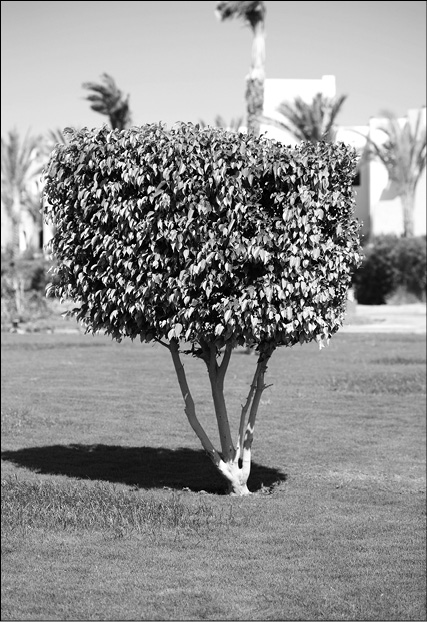
Chapter 8: Pruning Deciduous Trees
Deciduous plants drop all of their leaves in fall or winter. Deciduous trees are divided into four groups determined by their leaf type, as well as leaf arrangement. These include:
1. Simple leaves located opposite each other on the stem. Maples and tree lilacs are examples of opposite simple leaf trees.
2. Simple leaves located alternately on the stem. Birch, poplars, and willows are alternate simple leaf trees.
3. Compound leaves located opposite each other on the stem. Ash and buckeye are examples of opposite compound leaf trees.
4. Compound leaves located alternately on the stem. Locust and walnut are examples of alternate compound leaf trees.
Deciduous leaves also come in four types: smooth, finely toothed, double-toothed sharp pointed, and lobed.
Some common types of deciduous trees include maple, crabapple, magnolia, and cottonwood. You should primarly prune these plants to create a strong, well-balanced branch system that, in turn, makes the plant more attractive and healthier. Aside from these reasons, you need to prune a deciduous tree in cases of storm damage from heavy snows or high winds or when a tree’s growth interferes with utility wires, poles, pathways, or buildings.
You also want to prune to remove dead or diseased branches because these could cause injury or property damage. In this case, you prune for safety reasons and for the health of the tree. Health also comes into play when you prune the crown of a tree to increase airflow and also reduce some pests. Storm damage can leave a ragged wound in the tree. A severe wound may not seal and can kill the tree. Pruning a damaged tree helps the tree heal and, thus, produces a healthier tree.
Pruning Young Trees
You should not prune young trees until the second year after you plant them because leaves provide a young tree or shrub with nourishment needed when first planted in the ground, and the buds on the ends of the branches send hormones to the roots that promote growth. Once you begin to prune, do it carefully and gradually because removing too many branches will slow the growth of the tree.
Do not rush when cutting off branches; rather, you should prune gradually, especially if you are new at the technique. Plan which branches you want to prune before you begin. Pruning should make the plant look better and keep it healthy, and random cuts will leave you with an ugly, unhealthy tree. Unless you are creating a specialized shape — as in the cases of bonsai, topiary, pleaching, or standards — keep to your tree’s natural shape.
Begin by cutting just above an outward-facing bud. In spring, this bud will produce a side shoot that grows away from the tree. Do not prune any of the pink-colored growths because these are new growths from the previous year. Prune any black-colored shoots, and make sure you prune these by the third year. By the tree’s fifth year, it is considered a mature tree. From this point on, prune all growth from the center of the tree and also any dead or diseased branches.
If you want to create a landscaped tree, or a tree that has been arranged or pruned in order to provide a desired visual picture, you would want to have a length of bare trunk with a crown at the top. A bare trunk gives the tree some clearance room underneath. You can prune back the central leader branch so you get a bushier tree, but you have to spend a good deal of time pruning the tree every year, as another branch will try to take over as the leader. When pruning deciduous trees, leave the trunk and leader branch alone, and instead prune off branches that form narrow angles with the trunk. Also, prune branches that crowd the interior of the plant or do not flow with the shape you are creating. In addition, you will need to prune the suckers that grow from the base, as well as water sprouts growing upright from the branches.
Light pruning — only removing small, damaged, or diseased branches — can be done at any time of the year. You must do it sparingly so your tree does not bleed. For more extensive pruning, the most favorable time to prune deciduous trees is late winter to early spring when the tree is dormant. Winter is also when fewer insects can feed on the wound and cause damage to the tree’s health. The exceptions to these standard pruning rules are birches and maples. These trees will bleed sap in spring, and you should prune them in the coldest part of winter when they are fully dormant. This allows ample time for wound closure to occur in late summer to early fall when maples will lose less sap.
If your tree produces blooms on new wood, usually in summer, prune in late winter or early spring. When a tree is pruned before new growth appears, it will produce more flowers. If your tree blooms on old wood, usually in spring, do your pruning immediately after the blooms fade so you can avoid cutting off new flower buds. This will stimulate growth of more buds for the following year. You should understand the important characteristics of your tree before you prune it. Be sure to confirm its type when you purchase the tree or before you start to prune.
Finally, pruning at the correct time of year negates the necessity of having to dress or paint the wound, even though that is often discouraged. It was once believed that dressing or pruning paint was essential to seal the wound, but this is no longer the school of thought. In fact, dressing or pruning paint can actually harbor microorganisms and also slow the tree’s ability to heal its wounds.
Ornamental Pruning
Ornamental deciduous trees — typically smaller trees than the other trees in your garden — produce colorful flowers or leaves, instantly adding a focal point to your yard. Most ornamental trees average about 25 feet in height and include crabapple, dogwood, cherry, plum, pear, red bud, and magnolia.
Just as with all deciduous trees, the reasons for pruning remain the same: health, beauty, and safety. First, remove any dead or diseased branches, which you can do any time of year. If the limb is small, use pruning shears. For larger branches, use a pruning saw.
For more extensive pruning, prune during the tree’s dormancy period, usually during winter or early spring. Start from the bottom of the tree, and prune upward. Prune branches at the collar, cut at an angle, and leave a small part of that collar on the trunk. Remove lower limbs because they can weaken the tree. Once you have removed those lower branches in accordance with the overall shape you seek, prune limbs and water sprouts from the inside of the tree to the outside. Make sure to remove all water sprouts because these can easily overtake your tree. Also, make sure you keep your tree trunk as a single stem so it grows strong and less likely breaks in extreme weather conditions. Prune any cross branches. If your ornamental tree is by a sidewalk or lines your driveway, also prune any branches that may obstruct vision or make it difficult for pedestrians to pass on the sidewalk. As always, prune with purpose, but also prune gradually. Do not be afraid to step back and observe your handiwork to ensure thoughtful and creative pruning.

This well-pruned deciduous tree is an ornamental addition to a garden in Florida.